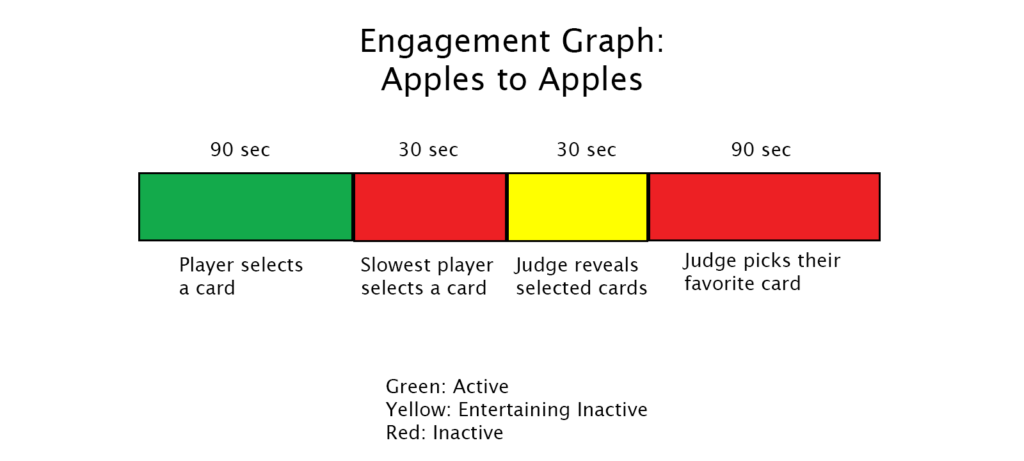In The Arty of Party: Part 1 I wrote about the party game genre in general and described some of the subgenres. This week, I’ll go into the nitty-gritty of designing your party game, in particular running it through playtests. If you’ve primarily worked in strategy games or similar, you’ll find the experience to be fairly different. However, it doesn’t require any special skills – you just need to evaluate the game in a different way than you’re used to.
“Writer’s Room” Playtests
As I mentioned, the majority of your work in a party game will be coming up with funny prompts. The average game will only use a tiny fraction of these, so to make sure that the majority of your prompts are funny, you’ll want to have two kinds of playtests: Regular ones where you show your game to people you don’t know, and what I call a “writer’s room” playtest.
To do this, you’ll need a group of friends and/or interested people who want to help work on your game. First, run two or three games with them so they understand how it works. Then, read off the list of prompts you’ve developed and, with their help, sort them into “Yes,” “Maybe,” and “No” piles. Throw out everything in the “No” pile and look at the “Maybe” prompts on a later date. Having a lot of people with different senses of humor is especially useful as you get more perspective on whether a prompt works or not.
For pitch games, it’s also important that all the cards flow grammatically with one another. Pick out five or so cards and, for each new one you create, briefly check to see if it sounds weird when combined with any of the other five. As you work alone and with your writer’s room, you’ll find yourself coming up with cards that meet the requirements more and more quickly as you get used to the constraints of your game.
It’s good to hold “writer’s room” playtests every couple of weeks as you continue to test your game and develop additional prompts.
Engagement
When you do your regular playtests, the most important thing, obviously, is that everyone has fun. However, there’s a more scientific approach than constantly interviewing your players to see if they enjoyed it.Though it’s difficult to quantify fun, it’s much easier to quantify engagement, and if your game is good enough, engagement should be fun anyway.
Engagement is a concern for strategy games, as well – it’s no fun to wait helplessly for several minutes as Slow-Play Steve spends forever thinking about his turn – but even a short period of nonengagement in a party game can be fatal. The best way to tell how engaged players will be in your party game is to create a time diagram, mentally or on paper, of how a round passes.
Within this diagram, create three categories: Action, where the player makes a choice or otherwise does something; Entertaining Inaction, where the player isn’t doing anything but is being entertained by another player; and Inaction, where the player is just twiddling their thumbs and waiting for something to happen. Then, run your prototype for a few rounds and create a rough graph of how long a player spends in each state and when. Here’s an example graph for a round of a non-judge player playing Apples to Apples:
These graphs are inevitably very rough but they help you visualize how much each player gets to participate over the course of a round.
Also important is the number of players engaged at one time. As you can see from the graph, only the judge gets to be active for the majority of the round of Apples to Apples. However, in the game Quiplash, all but two players serve as the “judge” for each round, meaning that, although the selection/judgement flow is essentially the same, many more players are actively participating for the majority of the round. In this way, even though the engagement chart would look similar, the game overall is more engaging and fun.
Diversity
Making sure your party game appeals to a wide audience is one of the best ways to ensure it’s a good game. Bring the game to places with a wide variety of age ranges, senses of humor, and experience levels with games to make sure everyone has a good time. This also applies to setting: A bar or a party is a different place than your weekly game night, and it will be more challenging for anyone to focus on a game there.
Even within your friend group, you can test for whether the game appeals to a diverse audience. Think about the shiest, most quiet person playing: Are they enjoying the game? Are they winning about as often as anyone else at the table? If the answer is yes, your game is essentially accomplishing what it’s supposed to by allowing everyone to participate in the generation of jokes.
As you test for wide outreach, you may find that parts of your game aren’t accessible to everyone. For example, when I tested Stand Back, Citizen!, I found that the real-time gameplay, which emphasized being able to put together a combination of cards as fast as possible, was difficult for people who didn’t fluently understand English. If there’s any way that the core concept of your game can expand to be more accessible, make it a priority.
It’s Time To Party
Even if you aren’t interested in creating a party game, I hope these two essays have at least convinced you that party games require just as much rigor as any other game design. If you’re mostly used to games that involve a lot of silent thinking, you might want to dip a toe into the pool of making your players laugh. A peek into player psychology can benefit anyone!
